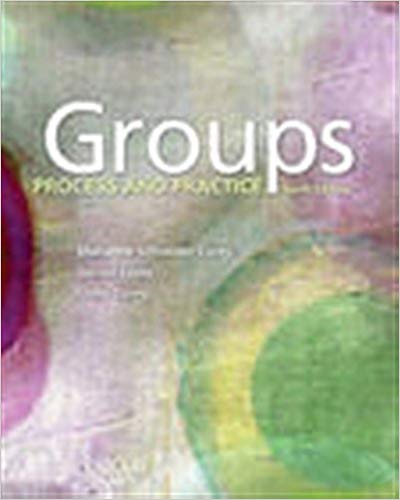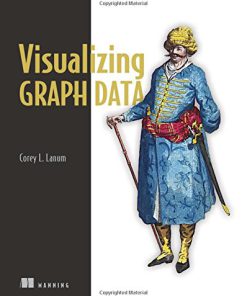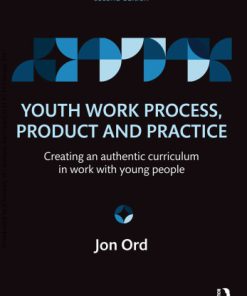Groups Process and Practice 1st Edition by Marianne Schneider Corey, Gerald Corey, Cindy Corey ISBN 9781305865709 1305865707
$50.00 Original price was: $50.00.$25.00Current price is: $25.00.
Groups Process and Practice 1st Edition by Marianne Schneider Corey, Gerald Corey, Cindy Corey – Ebook PDF Instant Download/Delivery: 9781305865709 ,1305865707
Full download Groups Process and Practice 1st Edition after payment
Product details:
ISBN 10: 1305865707
ISBN 13: 9781305865709
Author: Marianne Schneider Corey, Gerald Corey, Cindy Corey
Groups Process and Practice 1st Edition Table of contents:
Part One. Introduction: Basic Issues in Group Work
Chapter 1. Introduction to Group Work: A Multicultural Perspective
Introduction
An Overview of Various Types of Groups
Task Groups
Psychoeducational Groups
Counseling Groups
Psychotherapy Groups
Brief Groups
A Multicultural Perspective on Group Work
Becoming a Culturally Skilled Group Counselor
A Starting Place: Understanding Your Own Culture
A Personal Perspective on Understanding Differences
Multicultural and Social Justice Counseling Competencies
Inviting Conversations About Culture With Group Members
Points to Remember: Introduction to Group Work: A Multicultural Perspective
Exercises
Guide to Groups in Action: Evolution and Challenges DVD and Workbook
Chapter 2. The Group Counselor
Introduction
The Group Counselor as a Person
Problems and Issues Facing Beginning Group Leaders
Personal Characteristics of the Effective Group Leader
The Group Counselor as a Professional
Overview of Group Leadership Skills
An Integrated View of Leadership Skills
The Coleadership Model
The Basis of Coleadership
Advantages of the Coleadership Model
Disadvantages of the Coleadership Model
Developing a Research Orientation to Practice
Research on Common Factors
How Research Can Enhance Your Group Practice
The Challenge of Combining Research and Practice
Points to Remember: The Group Counselor
Exercises
Chapter 3. Ethical and Legal Issues in Group Counseling
Introduction
Ethical Issues in Group Membership
Informed Consent
Involuntary Membership
Freedom to Withdraw From a Group
Psychological Risks for Members
Confidentiality
Educating Members About Confidentiality
Ethical and Legal Dimensions of Confidentiality
Multicultural Dimensions of Confidentiality
Confidentiality of Minors in Groups
Summary Guidelines Regarding Confidentiality
The Role of the Leader’s Values in the Group
Ethical Aspects of Working With Values
Dealing With Conflicts of Values
The Ethical Imperative of Addressing Diversity in Group Counseling
Values and Working With Diversity
Ethics and Standards of Preparation and Practice
Social Justice Approach to Group Counseling
Special Issues Pertaining to Sexual Orientation
Ethical Concerns in Using Group Techniques
Competence and Training of Group Counselors
Competence as an Ongoing Developmental Process
Professional Training Standards for Group Counselors
Adjuncts to a Training Program
Ethical Issues in Training Group Counselors
Guidelines for Ethical and Legal Practice
Legal Liability and Malpractice
Legal Safeguards for Group Practitioners
Points to Remember: Ethical and Legal Issues in Group Counseling
Exercises: In-Class Activities
Chapter 4. Theories and Techniques of Group Counseling
Introduction
Theory as a Roadmap
Our Theoretical Orientation
Developing Your Own Theory of Group Practice
Using Group Techniques Effectively
Rationale for Use of Techniques
Viewing a Group Through a Multicultural Lens
Relationship of Theories to Techniques
Psychodynamic Approaches
Psychoanalytic Approach
The Adlerian Approach
Experiential and Relationship-Oriented Approaches
The Existential Approach
The Person-Centered Approach
Gestalt Therapy
Psychodrama
Cognitive Behavioral Approaches
Behavior Therapy
Cognitive Therapy
Rational Emotive Behavior Therapy
Choice Theory/Reality Therapy
Postmodern Approaches
Solution-Focused Brief Therapy
Narrative Therapy
Motivational Interviewing
Feminist Therapy
An Integrative Approach
Points to Remember: Theories and Techniques of Group Counseling
Exercises: Questions for Discussion
Guide to Groups in Action: Evolution and Challenges DVD and Workbook
Part Two. Group Process: Stages of Development
Chapter 5. Forming a Group
Introduction
Developing a Proposal for a Group
Working Within the System
Attracting and Screening Members
Guidelines for Announcing a Group and Recruiting Group Members
Screening and Selection Procedures
Practical Considerations in Forming a Group
Group Composition
Group Size
Frequency and Duration of Meetings
Length of a Group
Place for Group Meetings
Open Versus Closed Groups
The Uses of a Pregroup Meeting
Research on the Value of Pregroup Preparation
Orientation and Preparation of Members at a Pregroup Meeting
Clarifying Leader and Member Expectations
Goals of Pregroup Preparation
Establishing Basic Ground Rules
Building Evaluation Into Group Work
Coleader Issues on Forming a Group
Points to Remember: Forming a Group
Exercises: Group Planning
Guide to Groups in Action: Evolution and Challenges DVD and Workbook
Chapter 6. Initial Stage of a Group
Introduction
Group Characteristics at the Initial Stage
Some Early Concerns
Initial Hesitation and Cultural Considerations
Identifying and Exploring Common Fears of Group Members
Hidden Agendas
Address Conflict Early
Self-Focus Versus Focus on Others
Here-and-Now Focus Versus There-and-Then Focus
Trust Versus Mistrust
Creating Trust: Leader and Member Roles
The Importance of Modeling
Attitudes and Actions Leading to Trust
Identifying and Clarifying Goals
General Goals for Group Members
Helping Members Define Personal Goals
Group Process Concepts at the Initial Stage
Group Norms
Group Cohesion
Effective Therapeutic Relationships: Research Findings
Support Versus Confrontation
Guidelines for Creating Therapeutic Relationships With Members
Helping Members Get the Most From a Group Experience
Leader Guidelines for Members
Avoid Too Much Structuring and Teaching
Journal Writing as an Adjunct to Group Sessions
Homework During the Initial Stage
Leader Issues at the Initial Stage
Division of Responsibility
Degree of Structuring
Opening and Closing Group Sessions
Points to Remember: Initial Stages of a Group
Exercises: Facilitation of Initial Stage of a Group
Guide to Groups in Action: Evolution and Challenges DVD and Workbook
Chapter 7. Transition Stage of a Group
Introduction
Characteristics of the Transition Stage
Establishing Trust
Defensiveness and Reluctant Behavior
A Critique of the Notion of Resistance
Common Fears and Anxieties Experienced by Members
Struggles With Control
Conflict
Confrontation
Challenges to the Group Leader
The Leader’s Reactions to Defensive Behaviors
Group Members Who Pose a Challenge for Leaders
Silence and Lack of Participation
Monopolistic Behavior
Storytelling
Questioning
Giving Advice
Dependency
Offering Pseudosupport
Hostile Behavior
Acting Superior
Socializing
Intellectualizing
Members Becoming Assistant Leaders
Dealing With Defensive Behavior Therapeutically
Dealing With Avoidance by the Whole Group
Dealing With Transference and Countertransference
Coleader Issues at the Transition Stage
Points to Remember: Transition Stage of a Group
Exercises: Self-Assessment Scale for Group Members
Guide to Groups in Action: Evolution and Challenges DVD and Workbook
Chapter 8. Working Stage of a Group
Introduction
Progressing to the Working Stage
Leader Interventions in Working With a Member’s Fear
Interventions at the Initial Stage
Interventions at the Transition Stage
Interventions at the Working Stage
Interventions in the Final Stage
Tasks of the Working Stage
Group Norms and Behavior
Contrasts Between a Working Group and a Nonworking Group
Deepening Trust During the Working Stage
Choices to Be Made During the Working Stage
Homework During the Working Stage
Therapeutic Factors That Operate in a Group
Self-Disclosure and the Group Member
Self-Disclosure and the Group Leader
Feedback
Confrontation
Cohesion and Universality
Hope
Willingness to Risk and to Trust
Caring and Acceptance
Power
Catharsis
The Cognitive Component
Commitment to Change
Freedom to Experiment
Humor
Coleader Issues During the Working Stage
Topics for Coleader Meetings
Points to Remember: Working Stage of a Group
Exercises: Assessment of the Working Stage
Guide to Groups in Action: Evolution and Challenges DVD and Workbook
Chapter 9. Final Stage of a Group
Introduction
Tasks of the Final Stage of a Group: Consolidation of Learning
Termination of the Group Experience
Group Proposals Illustrate Ending of a Group
Dealing With Feelings of Separation
Comparing Early and Later Perceptions in the Group
Dealing With Unfinished Business
Personal Gestures in Expressing the Meaning of a Group Experience
Reviewing the Group Experience
Practice for Behavioral Change
Carrying Learning Further
Giving and Receiving Feedback
Use of a Contract and Homework
Dealing With Setbacks
Guidelines for Applying Group Learning to Life
Reminding Members About Confidentiality
Evaluation of the Group Experience
Coleader Issues as the Group Ends
Follow-Up
Postgroup Sessions
Points to Remember: Final Stage of a Group
Exercises: Final Stage of a Group
Guide to Groups in Action: Evolution and Challenges DVD and Workbook
Part Three. Application of Group Process to Schools and Community Agency Settings
Chapter 10. Groups in School Settings
Introduction
Group Counseling in the School Setting
Guidelines for Group Work With Children and Adolescents
Developing a Sound Proposal
Legal Considerations
Practical Considerations
Strategies in the Group
Personal and Professional Qualifications
Getting Support for School Counseling Groups
Play Therapy in Group Work With Children and Adolescents
Developmental Themes of Adolescence
Sources of Stress During Adolescence
Developmental Group Counseling With Adolescents
Issues and Challenges in Leading Adolescent Groups
Establishing Trust
Know Your Comfort Zone With Self-Disclosure
Helping Adolescents Deal With Anger and Conflict
Groups in College Counseling Centers
Common Topics in College Groups
Some Groups for College Students
Points to Remember: Groups in School Settings
Exercises: In-Class Activities
Chapter 11. Groups in Community Settings
Introduction
Group Work With Women
Group Work With Men
Group Treatment of Domestic Violence Offenders
Group Treatment for People With Substance Use Disorders
Group Work With Older Adults
Attitudes, Knowledge, and Skills of Leaders
Preparing Yourself to Work With Older Adults
Practical and Professional Considerations for Group Work With Older Adults
Guidelines for the Group Process
Working With Healthy Aging People in Groups
The Therapeutic Value of Grief Work in Groups
Points to Remember: Groups in Community Settings
Exercises: In-Class Activities
Introduction
New to This Edition
Synopsis of the Educational Programs
Learning Objectives for Groups in Action: Evolution and Challenges
Resource Textbooks
Welcome to the Self-Study Program
How to Make Best Use of the Video and Workbook
A Guide for Reviewing the Program: Evolution of a Group
About the Participants
The First Program: Evolution of a Group
The Second Program: Challenges Facing Group Leaders
Group Leadership Skills: A Checklist
First Program. Evolution of a Group
Part I. Forming a Group
Coreys’ Commentary: Introduction
About Forming This Group
Pregroup Meeting
Importance of Preliminary Preparation
Summary of Issues in Forming a Group
Member Functions
Leader Functions
Questions for Discussion and Reflection
Part II. The Initial Stage
Self-Inventory
The First Session
Questions for Discussion and Reflection
Introducing the Group Members
Setting Goals
Early Developments and Interactions
Some Teaching About Group
The Dyad Exercise
Our Goals and Expectations for the Beginning of a Group
Full Participation
Shared Responsibility
Role Plays
Here and Now
Making Contracts
Direct Talk
Look and See
Avoiding Quick Solutions
Dealing with Conflict
What will Get in Your Way in This Group?
A Coleadership Style
Coreys’ Commentary: The Initial Stage
Summary of the Initial Stage
Basic Characteristics of the Initial Stage
Member Functions
Leader Functions
Questions for Applying the Summary List
In-Class Exercise: Questions for Small Group Discussion and Reflecting Teams
Part III. The Transition Stage
Self-Inventory
Building Safety
Linking the Work of Members
“How was the Day?”
Opening and Closing a Group Session
Checking-In Process
Checking-Out Process
Coreys’ Commentary: The Transition Stage
Checking in with Members
Furthering of Trust Building
Creating Safety
Coreys’ Commentary: More on the Transition Stage
Summary of the Transition Stage
Basic Characteristics of the Transition Stage
Member Functions
Leader Functions
Questions for Applying the Summary List
In-Class Exercise: Questions for Small Group Discussion and Reflecting Teams
Part IV. The Working Stage
Self-Inventory
Who Wants to Work?
Commentary on Casey’s Work
Symbolic Exploration Through Role Playing
Involving Other Members in Intensive Work
Jyl’s Loss of Her Father
Never Good Enough
Wanting Approval
Linking Members by Role Playing
Working with Metaphors
Working with Relationships
Andrew’s Struggle of Keeping Pain Inside
Coreys’ Commentary: The Working Stage
Summary of the Working Stage
Basic Characteristics of the Working Stage
Member Functions
Leader Functions
Questions for Applying the Summary List
In-Class Exercise: Questions for Small Group Discussion and Reflecting Teams
Part V. The Ending Stage
Self-Inventory
Reflecting on Afterthoughts
Preparing Members for Termination
Consolidating Learning
Dealing with Unexpected Conflict
Keeping Members Focused
Noticing Changes and Taking Credit for Them
Coreys’ Commentary: The Ending Stage
Summary of the Ending Stage
Basic Characteristics of the Ending Stage
Member Functions
Leader Functions
Questions for Applying the Summary List
In-Class Exercise: Questions for Small Group Discussion and Reflecting Teams
Part VI. Ethical Issues in the Practice of Group Counseling
Ethical Issues in the Practice of Group Counseling
Part VII. Follow-Up Self-Inventory
Follow-Up Self-Inventory
Part VIII. Some Final Thoughts
Some Final Thoughts
Where Are You Now and Where Will You Go from Here?
Second Program. Challenges Facing Group Leaders
Part I. Overview
How and Why This Second Program Originated
About This Second Program
Our Experience as Coleaders
The Seating Arrangement
How to Use the Video and the Workbook
Part II. Challenges of Dealing with Difficult Behaviors in Group
Introductory Commentary
Key Points in the Commentary
Checking In: What Was It Like to Return to Group?
Narration
Key Points in the Group Session
Your Reflections and Responses
Group Leaders’ Reflections
The Leaders Let Me Down
Narration
Key Points in the Group Session
Your Reflections and Responses
Group Leaders’ Reflections
I’m Not Feeling Safe in Here
Narration
Key Points in the Group Session
Your Reflections and Responses
Group Leaders’ Reflections
I Didn’t Want to Come Back to Group
Narration
Key Points in the Group Session
Your Reflections and Responses
Group Leaders’ Reflections
I’m in This Group Against My Will
Narration
Key Points in the Group Session
Your Reflections and Responses
Group Leaders’ Reflections
Emotions Make Me Uncomfortable
Narration
Key Points in the Group Session
Your Reflections and Responses
Group Leaders’ Reflections
I’m Self-Conscious About My Accent
Narration
Key Points in the Group Session
Your Reflections and Responses
Group Leaders’ Reflections
I Want the Leaders to Disclose More
Narration
Key Points in the Group Session
Your Reflections and Responses
Group Leaders’ Reflections
I Learn a Lot by Being Quiet
Narration
Key Points in the Group Session
Your Reflections and Responses
Group Leaders’ Reflections
Commentary
Key Points in the Commentary
In-Class Exercise: Questions for Small Group Discussion and Reflecting Teams
Silence Serves a Function
Narration
Key Points in the Group Session
Your Reflections and Responses
Group Leaders’ Reflections
I Feel Pressured to Disclose
Narration
Key Points in the Group Session
Your Reflections and Responses
Group Leaders’ Reflections
What’s Wrong with Helping Others?
Narration
Key Points in the Group Session
Your Reflections and Responses
Group Leaders’ Reflections
Can’t We Stop All This Conflict?
Narration
Key Points in the Group Session
Your Reflections and Responses
Group Leaders’ Reflections
I Feel Weak When I Show Feelings
Narration
Key Points in the Group Session
Your Reflections and Responses
Group Leaders’ Reflections
Checking Out: What Is Each of You Taking from This Session?
Narration
Key Points in the Group Session
Your Reflections and Responses
Group Leaders’ Reflections
Commentary
Key Points in the Commentary
In-Class Exercise: Questions for Small Group Discussion and Reflecting Teams
Part III. Challenges of Addressing Diversity Issues
What Does My Culture Have to Do with My Identity?
Narration
Key Points in the Group Session
Your Reflections and Responses
Group Leaders’ Reflections
I Feel Different from Others in Here
Narration
Key Points in the Group Session
Your Reflections and Responses
Group Leaders’ Reflections
Sometimes I Want to Exclude Others
Narration
Key Points in the Group Session
Your Reflections and Responses
Group Leaders’ Reflections
I Struggle with Language
Narration
Key Points in the Group Session
Your Reflections and Responses
Group Leaders’ Reflections
I Resent Being Stereotyped
Narration
Key Points in the Group Session
Your Reflections and Responses
Group Leaders’ Reflections
We Are Alike and We Are Different
Narration
Key Points in the Group Session
Your Reflections and Responses
Group Leaders’ Reflections
I Express Myself Better in My Native Language
Narration
Key Points in the Group Session
Your Reflections and Responses
Group Leaders’ Reflections
I am Colorblind
Narration
Key Points in the Group Session
Your Reflections and Responses
Group Leaders’ Reflections
I Know Little About My Culture
Narration
Key Points in the Group Session
Your Reflections and Responses
Group Leaders’ Reflections
I Want More Answers from You Leaders
Narration
Key Points in the Group Session
Your Reflections and Responses
Group Leaders’ Reflections
Commentary
Narration
Key Points in the Commentary
Closing Commentary
In-Class Exercise: Questions for Small Group Discussion and Reflecting Teams
Where Are You Now and Where Will You go from Here?
In-Class Exercise: Questions for Small Group Discussion and Reflecting Teams
Third Program. Lecturette on Theories and Techniques of Group Counseling
Overview
Overview
Part I. Introduction
Introduction
Main Points
Questions for Reflection and Discussion
Part II. Lecturettes on Theoretical Approaches
Psychodynamic Approaches
Main Points
Questions for Reflection and Discussion
Experiential and Relationship-Oriented Approaches
Main Points
Questions for Reflection and Discussion
Cognitive Behavioral Approaches
Main Points
Questions for Reflection and Discussion
Postmodern Approaches
Main Points
Questions for Reflection and Discussion
An Integrative Approach
Main Points
Questions for Reflection and Discussion
Final Thoughts
References and Suggested Readings
People also search for Groups Process and Practice 1st Edition:
groups process and practice 9th edition pdf
groups process and practice 10th edition
groups process and practice
groups process and practice corey
Tags:
Marianne Schneider Corey,Gerald Corey,Cindy Corey,Groups,Process,Practice
You may also like…
Business & Economics - Management & Leadership
Entrepreneurship Theory Process Practice Fourth Edition Howard Frederick
Mathematics - Symmetry and group
Politics & Philosophy - Anthropology
Experimental Film and Anthropology 1st Edition Arnd Schneider
Computers - Databases
Uncategorized
Politics & Philosophy - Government & Politics
Arts - Performing Arts












